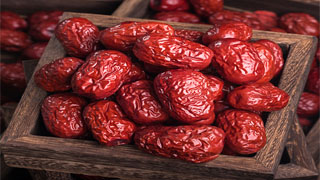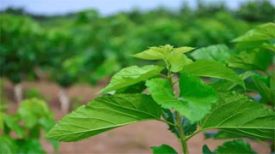
1. Alias
Jujube, dried jujube, beautiful jujube, good jujube, red jujube.
2. Plant morphology
Deciduous shrubs or small trees, up to 10 meters tall. The small leaves have paired needles, and the tender branches have fine hairs. Leaves alternate, elliptical ovate or ovate lanceolate, measuring 2.5-7 cm in length and 1.2-3.5 cm in width, with a slightly blunt tip and a skewed base. The edges have fine serrations, and the base has three veins. Small flowers, pale yellow green, 2-3 clustered axillary inflorescence; Calyx with 5 lobes; Petals 5; 5 stamens; The ovary and stigma are 2-lobed. The drupe is ovate to oblong in shape and deep red when ripe. The flowering period is from April to May, and the fruiting period is from July to September.
3. Origin distribution
Commonly found in loess, sandy, and sandy areas, it is drought tolerant and also cultivated in plains, hills, and valleys. Mainly produced in Henan, Hebei, Shandong and other places.
4. Harvesting and processing
Harvest fruits in autumn when they are ripe and dry them in the sun. Or dry until the skin is soft and then sun dry. Alternatively, first blanch the fruit with boiling water until the flesh is soft and the outer skin is not wrinkled, then remove it and dry it in the sun.
5. Characteristics of medicinal herbs
The fruit is elliptical or spherical, measuring 2-3.5 centimeters in length and 1.5-2.5 centimeters in diameter. The surface is dark red with a slight luster, irregular wrinkles, concave base, and short fruit stalks; The outer skin is thin, the middle skin is brownish yellow or light brown, fleshy, soft, rich in sugar and oily; The fruit core is spindle shaped, with sharp ends and a hard texture. It has a slight fragrance and a sweet taste.
6. Sexual Taste Returning to the Classics
Warm in nature, sweet in taste. The Spleen Meridian, Stomach Meridian, and Heart Meridian.
7. Effect and Function
Tonifying the middle and nourishing qi, nourishing blood and calming the mind. It belongs to the subcategory of Qi tonifying drugs under the category of deficiency tonifying drugs.
8. Clinical application
Take 6-15 grams and decoct in water. Used to treat spleen deficiency, insufficient food intake, deficiency of qi, blood, and body fluids, weakness, loose stools, and restlessness in women.
9. Pharmacological research
It has functions such as central inhibition, liver protection, muscle strength enhancement, anti allergic reaction, anti fatigue, anti-tumor, calming, increasing white blood cell cAMP, and enhancing immunity.
10. Chemical composition
Contains organic acids, quinoline alkaloids, and triterpenoids. Fresh fruits contain a large amount of vitamin C, as well as riboflavin, thiamine, carotene, niacin, vitamin E, baptine, methylfolinate, gibberellin, betulinic acid, jujube seed saponin A, jujube seed saponin B, jujube seed saponin I, jujube seed saponin II, jujube seed saponin III, etc. Fresh fruits have high sugar content, mainly including glucose, fructose, sucrose, etc., and also contain cyclic adenosine monophosphate, cyclic guanosine monophosphate, etc.
11. Usage taboos
Use with caution in cases of dampness, phlegm coagulation, food stagnation, insect accumulation, and pain caused by dental caries, as well as cough caused by phlegm heat.
12. Compatibility prescription
① To treat lung abscess, vomiting blood and reckless behavior: divide jujube (with nuclear burning properties) and hundred herbs decoction (calcined) into equal parts, with fine powder on top. Take 6 grams per serving and adjust to rice soup. (Two ashes scattered in the book 'Three Causes')
② Treatment for dry mouth: 90 grams of dried jujube meat, 60 grams of licorice (roasted), almonds, and black plums each. Mash the top four ingredients with honey and pills like jujube pits. Containing, stopping with lubrication difference. (Quoted from Zhang Wenzhong in "Outer Platform")
③ Treatment for hypertension: 10-15 jujubes and 60 grams of fresh celery and vegetable roots. Boil it in water. (Handbook of Chinese Herbal Medicine in Yan'an Region)
④ To treat pediatric oral ulcers: Use small red dates, remove the pits, add a little alum, burn it until fine, add 0.3 grams each of Xionghuang powder and Hai'er tea, mix well and apply. Wash your mouth with Jingjie decoction first, and then apply the medicine for immediate effect. (Lu Fu Ban Fang)
⑤ Treatment of non thrombocytopenic purpura: Wash with raw red dates and take orally, 3 times a day, 10 pieces per day, until the purpura disappears completely. Generally, each person needs 500 to 1000 grams of red dates. (Shanghai Journal of Traditional Chinese Medicine, 1962 (2): 22)
⊙ The content of the article is for clinical reference only. Non TCM professionals are not allowed to test drugs.


